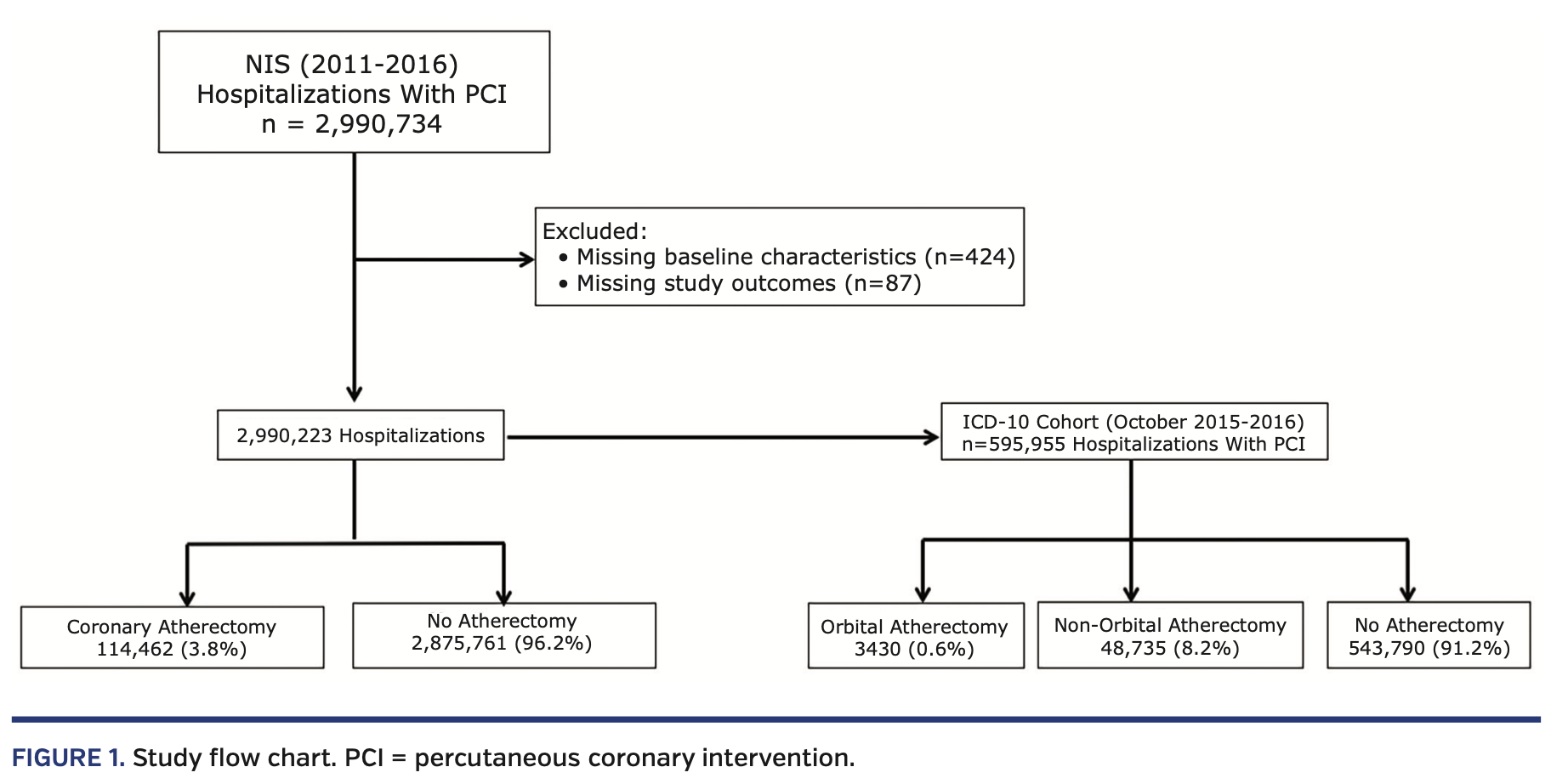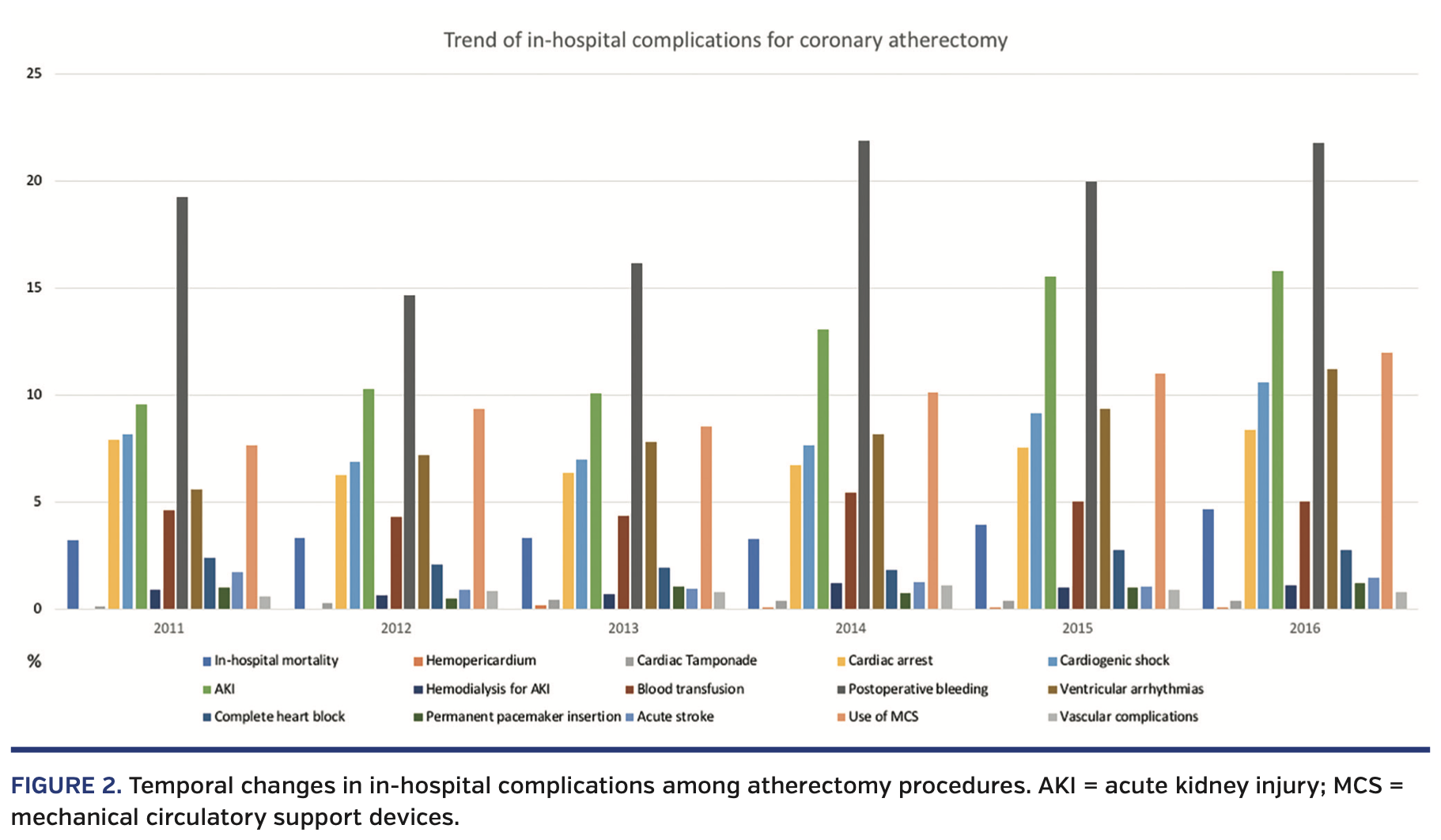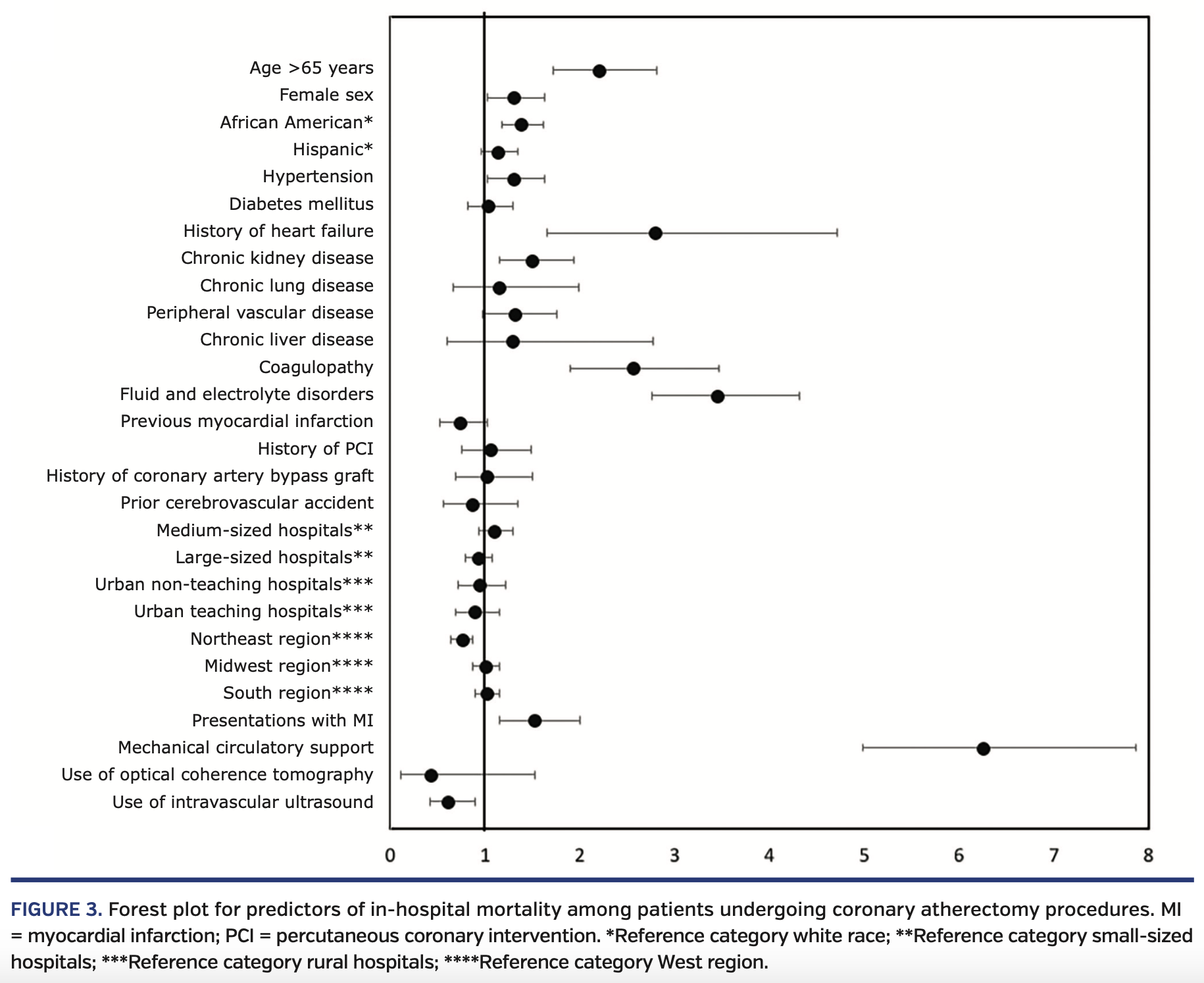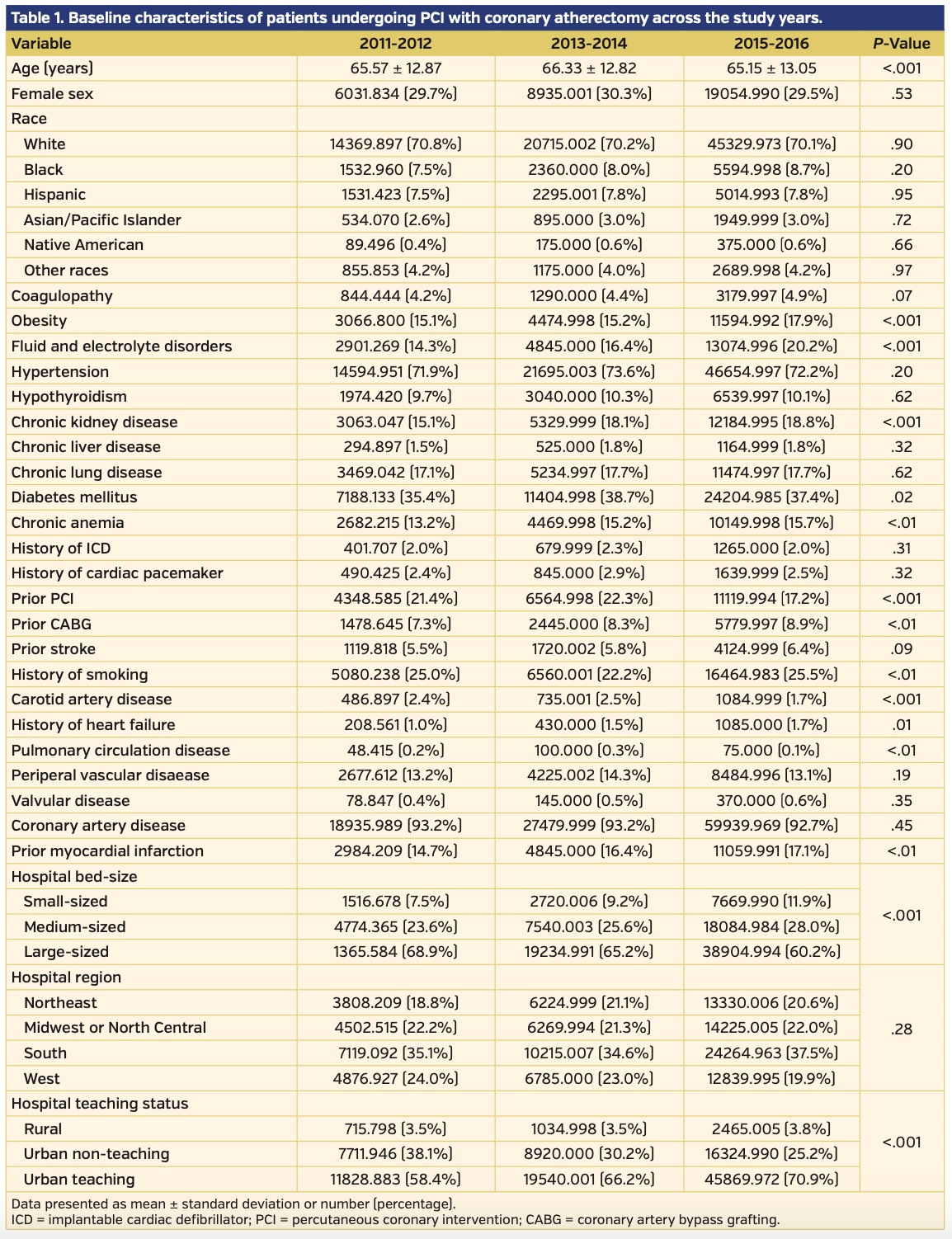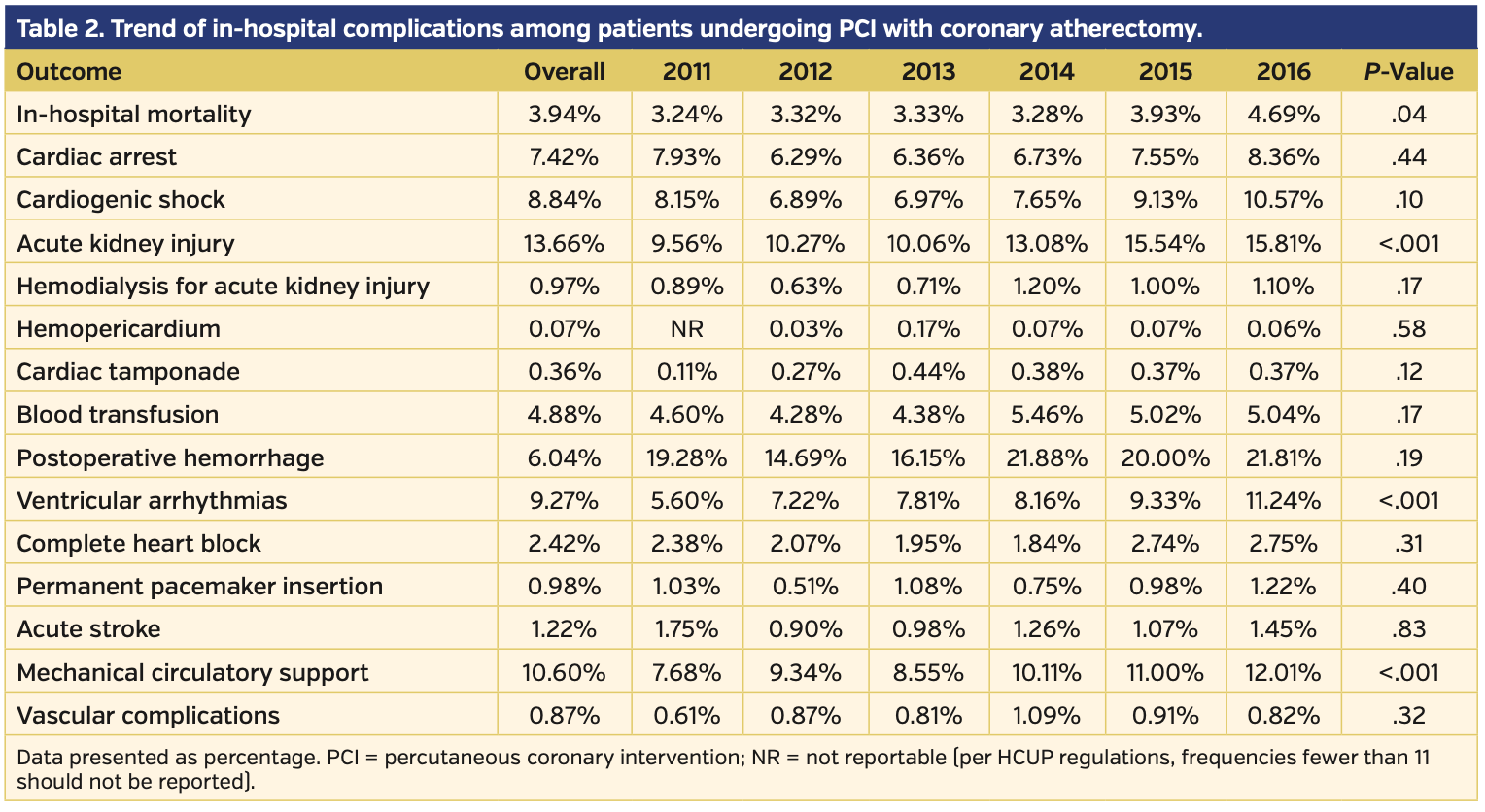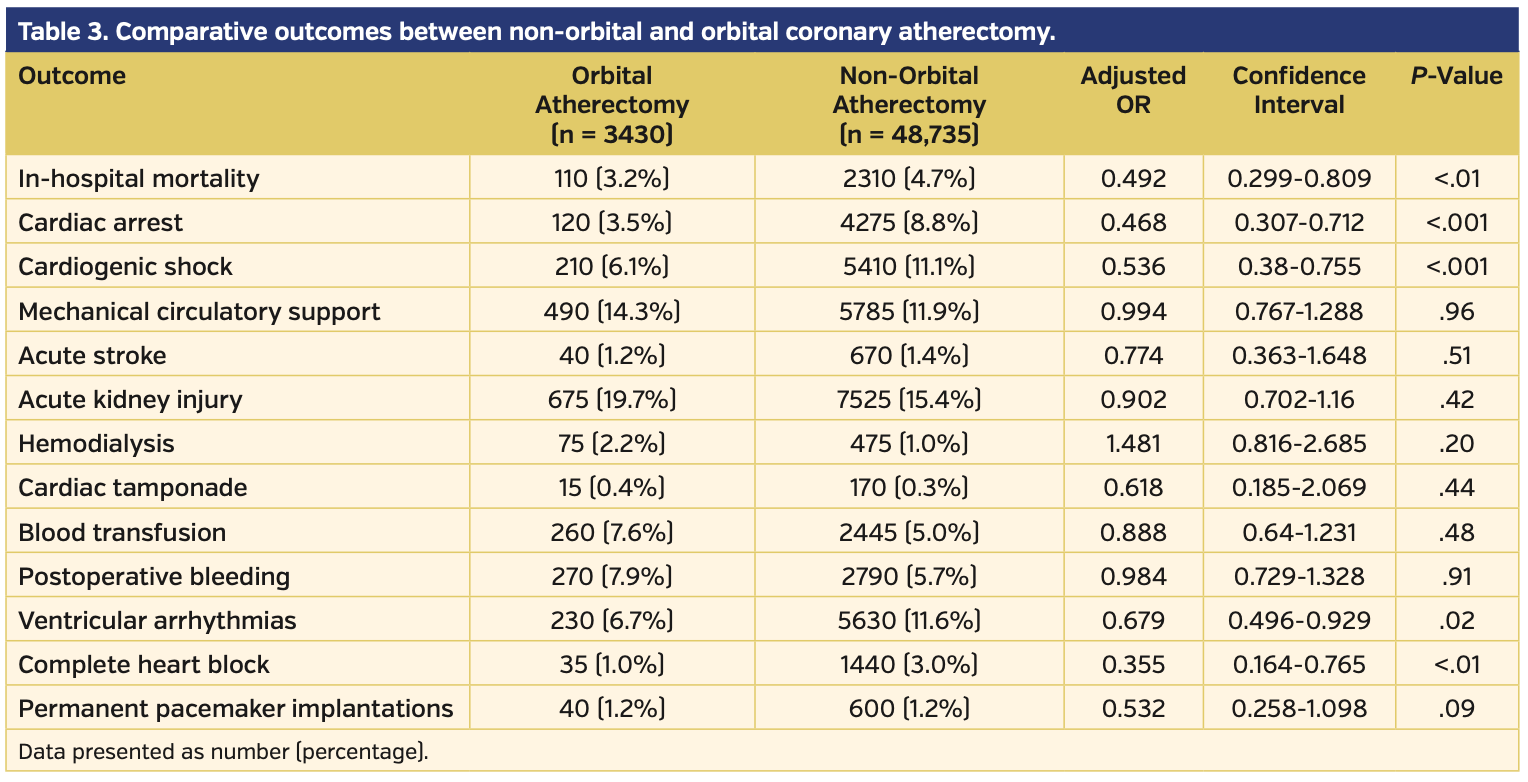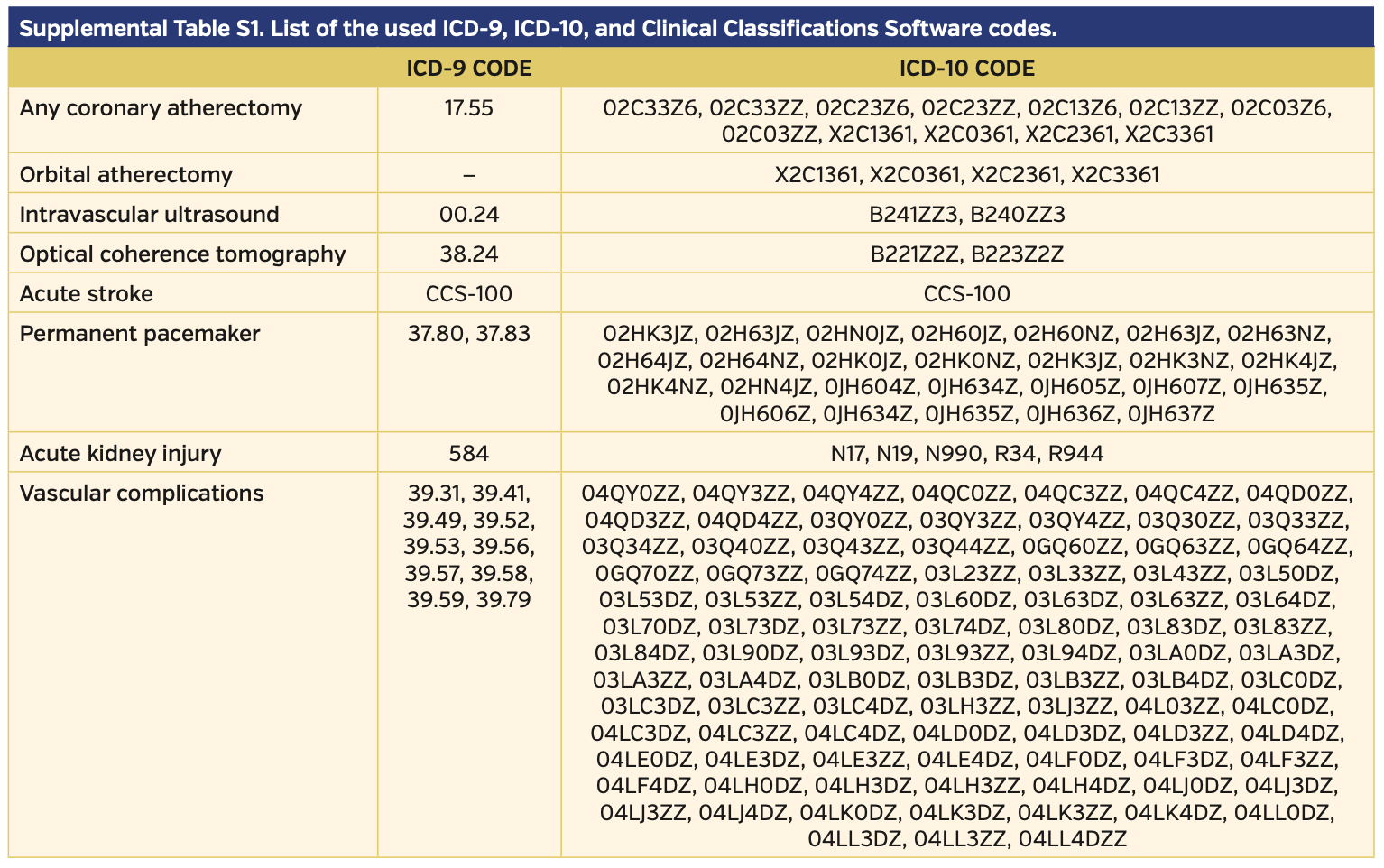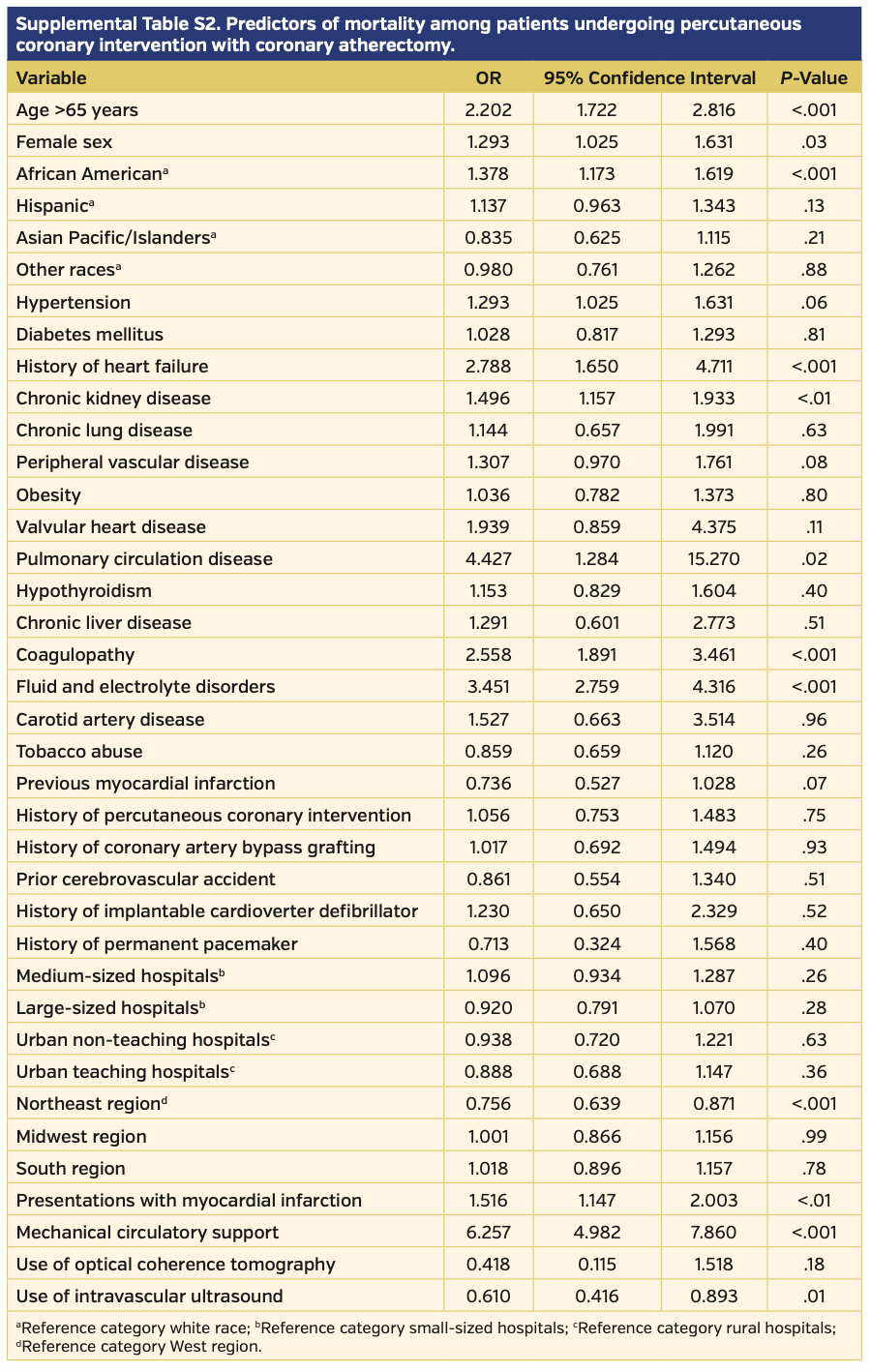ADVERTISEMENT
Temporal Trends and Outcomes of Percutaneous Coronary Atherectomy in the United States
Abstract: Background. There is paucity of data regarding the temporal trends and outcomes of coronary atherectomy in the United States. Methods. We queried the National Inpatient Sample database (2011-2016) for hospitalizations of patients undergoing coronary atherectomy procedures. We also compared outcomes of non-orbital vs orbital coronary atherectomy in a more contemporary cohort. Results. Our analysis included 2,990,223 hospitalizations with PCI, of which 114,462 (3.8%) included an atherectomy procedure. A significant increase in coronary atherectomy procedures was observed over time (0.66% in 2011 vs 8.9% in 2016; Ptrend=.04). There was an increase in in-hospital mortality associated with atherectomy procedures from 3.2% in 2011 to 4.7% in 2016 (Ptrend=.04), which paralleled the increase in patient comorbidities, use of mechanical circulatory devices (Ptrend<.001), and procedural complications. While several predictors of increased mortality after an atherectomy procedure were identified, the use of intravascular ultrasound (IVUS) was associated with lower mortality during atherectomy procedures (adjusted odds ratio [OR] = 0.61; 95% confidence interval [CI], 0.42-0.89), although its overall use was low (10.4%). Compared with other atherectomy procedures, orbital atherectomy was associated with lower in-hospital mortality (3.2% vs 4.7%; adjusted OR = 0.50; 95% CI, 0.30-0.81). Conclusion. Our large national database analysis demonstrates an increase in the number of coronary atherectomy procedures and in their in-hospital mortality and complications over time. Orbital atherectomy appears to be associated with favorable outcomes compared with non-orbital atherectomy, and IVUS use was associated with lower mortality during atherectomy procedures. These associations do not necessarily imply causality and need to be confirmed in future randomized clinical trials.
J INVASIVE CARDIOL 2020;32(5):E110-E121.
Key words: atherectomy, coronary artery disease, mortality rates
Coronary artery calcification is common in patients with coronary artery disease (CAD), with reported incidence of 38% by conventional angiography and a much higher incidence when evaluated by intravascular ultrasound (IVUS).1 With progressive aging of the population and increasing prevalence of risk factors such as diabetes and chronic kidney disease (CKD), prevalence of coronary calcification is expected to increase among patients undergoing percutaneous coronary intervention (PCI).2 Despite advances in PCI, managing patients with significant coronary artery calcification remains challenging and is associated with worse outcomes. Calcified coronary plaques preclude proper stent delivery and expansion, and carry significant risk for malapposed stents, balloon rupture, acute vessel dissection, and (potentially) stent thrombosis.2,3 PCI in calcified coronary plaques has significantly higher target-lesion revascularization and overall adverse cardiac event rates.4 Among different proposed treatment strategies for coronary calcification, atherectomy devices have emerged as a viable and promising solution. While studies have failed to show clinical benefits from routine atherectomy, coronary atherectomy procedures are currently used in complex coronary interventions with significant fibrotic or calcific plaques.5 Atherectomy can help in lesion preparation, facilitating stent delivery and expansion. It can potentially help achieve larger postprocedural luminal diameter, which has been linked to better long-term outcomes.5,6 Different atherectomy strategies are currently available, and include rotational atherectomy, laser atherectomy, and most recently orbital atherectomy. Real-world data on the contemporary trends and outcomes of coronary atherectomy procedures in the United States are lacking. Hence, we sought to explore the temporal trends and outcomes of coronary atherectomy during PCI using a large national database.
Methods
Data source. Our data source was the National Inpatient Sample (NIS) database. The NIS is part of the Healthcare Cost and Utilization Project (HCUP), sponsored by the Agency for Healthcare Research and Quality (AHRQ). The NIS is the largest publicly available inpatient care database in the United States.7 The NIS is derived from the billing data submitted by hospitals to statewide data organizations across the United States. The NIS includes data from all payers, including individuals covered by Medicare, Medicaid, private insurance, and the uninsured. Importantly, the NIS includes Medicare Advantage patients, a population that is often missing from Medicare claims data but comprises ∼30% of Medicare beneficiaries.8 The NIS large sample size enables analyses of uncommon treatments and special patient populations.8,9 The unweighted sample contains data on ∼7 million hospital stays each year, which represents roughly 20% of hospital admissions in the United States. By applying appropriate weighting samples, national estimates of admissions in the United States can be derived. The NIS has been used previously to describe trends and outcomes of coronary interventions in the United States.10,11 The NIS reports data using the International Classification of Diseases, Ninth Edition (ICD-9) until September 2015, while data from October 2015 until 2016 are reported using ICD-10 codes. This study was exempt from institutional review board evaluation, since the data used are deidentified and publicly available.
Study population and outcomes. We queried the NIS database (2011-2016) to identify hospitalizations with ICD-9 and ICD-10 codes for PCI. We then included hospitalizations for coronary atherectomy using ICD-9 code 17.55 and ICD-10 codes (orbital atherectomy: X2C1361, X2C0361, X2C2361, X2C3361; non-orbital atherectomy: 02C33Z6, 02C33ZZ, 02C23Z6, 02C23ZZ, 02C13Z6, 02C13ZZ, 02C03Z6, and 02C03ZZ). We excluded hospitalizations with missing data on baseline characteristics or any of the study outcomes.
We described the temporal changes in the uptake of coronary atherectomy procedure during the study period. We reported the baseline and hospital characteristics of hospitalizations for PCI with coronary atherectomy. We also reported the temporal changes in in-hospital complications and treatments among patients who received coronary atherectomy, including in-hospital mortality, cardiac arrest, cardiogenic shock, acute kidney injury (AKI), hemodialysis for AKI, acute stroke, ventricular arrhythmias, complete heart block, permanent pacemaker implantation, respiratory complications, hemopericardium, cardiac tamponade, vascular complications, and the use of mechanical circulatory support (MCS) device. Since ICD-9 codes do not differentiate between orbital and non-orbital atherectomy, we applied the comparative analysis of in-hospital outcomes between orbital vs non-orbital atherectomy from October 2015 through 2016. Using the contemporary data with ICD-10 codes, we compared in-hospital outcomes for orbital atherectomy vs non-orbital atherectomy as well as evaluated clinical predictors of in-hospital mortality among hospitalizations for any coronary atherectomy procedure. Procedures, clinical characteristics, and inpatient outcomes were abstracted and reported using ICD-9 and ICD-10 codes, Clinical Classifications Software (CCS) codes and Elixhauser comorbidities as reported by HCUP (Supplemental Table S1).
Statistical analyses. To estimate the temporal changes during the study period, we used time series plots and interrupted time series regression models. We conducted multivariable regression analysis to compare in-hospital outcomes for non-orbital atherectomy vs orbital atherectomy. The model included the following 27 clinical and hospital variables: age, sex, race, obesity, diabetes mellitus, hypertension, history of heart failure, chronic lung disease, peripheral vascular disease, pulmonary circulation disorders, chronic liver disease, CKD, chronic anemia, fluid/electrolyte disturbances, coagulopathy, hypothyroidism, history of smoking, history of implantable cardiac defibrillator, history of cardiac pacemaker, carotid artery disease, CAD, prior stroke, prior myocardial infarction (MI), prior PCI, prior coronary artery bypass grafting (CABG), hospital bed-size, hospital region, and hospital teaching status. We conducted another multivariable regression analysis to evaluate clinical predictors of in-hospital mortality among patients undergoing any coronary atherectomy procedure. The model included the same aforementioned variables in addition to presentation with acute MI, MCS device use, IVUS use, and optical coherence tomography (OCT) use. For the regression analysis models, we included variables that were statistically significant on univariate regression analyses and forced as well into the model additional variables that have been well established in prior studies to impact PCI outcomes.
All outcomes were analyzed using the complex samples facility of SPSS to account for hospital strata, clustering, and weights.12 All analyses were conducted using the appropriate weighting samples in accordance with HCUP regulations.12 Categorical variables were compared using Chi-square test or Fisher’s exact test as appropriate and continuous variables were compared using the Student’s t-test. Categorical variables were expressed as numbers and percentages, while continuous variables were reported as mean ± standard deviation or median (interquartile range) as appropriate. Associations were considered significant if the P-value was <.05. We used SPSS Statistics for Windows, version 24.0 (2016; IBM) for all statistical analyses.
Results
Trends in coronary atherectomy procedures. Our analysis initially included 2,990,734 hospitalizations with PCI from 2011 to 2016. After excluding hospitalizations with missing data on baseline characteristics (n = 424) and study outcomes (n = 87), we had a total of 2,990,223 hospitalizations. Of those, a total of 114,462 (3.8%) had coronary atherectomy. In the era of ICD-10 codes (4th quarter 2015 to 2016), a total of 595,955 PCIs were performed, of which 3430 (0.6%) underwent orbital atherectomy and 48,735 (8.2%) underwent non-orbital atherectomy (Figure 1).
During the study time period, there was a rising trend in PCI with coronary atherectomy from 3607 (0.66%) in 2011 to 42,750 (8.9%) in 2016 (Ptrend=.04). The rising trend was observed for coronary atherectomy in the setting of acute MI (2328 [0.9%] in 2011 to 31,050 [10.0%] in 2016; Ptrend=.03) as well as in the non-MI setting (1279 [0.5%] in 2011 to 11,700 [7.0%] in 2016; Ptrend=.01). In the era of ICD-10 codes, there was a rising trend in PCI with orbital atherectomy from 335 (0.3%) in 4th quarter 2015 to 950 (0.8%) in 4th quarter 2016 (Ptrend=.03).
Table 1 outlines baseline characteristics for patients undergoing coronary atherectomy during the study years. Over time, there was an increase in the prevalence of obesity, diabetes, chronic anemia, CKD, fluid/electrolyte disturbances, prior CABG, prior MI, and history of heart failure. Also, coronary atherectomy became more widely performed in small-sized and medium-sized hospitals over time, and was also increasingly being performed more in teaching centers compared with non-teaching centers. The use of IVUS in PCI with coronary atherectomy was 10.4%, with no change in the trend over time (8.7% in 2011 vs 10.5% in 2016; Ptrend=.23). The use of OCT was 0.5%, with no significant trend change (0.41% in 2011 vs 0.42% in 2016; Ptrend=.50).
In-hospital mortality and complications with coronary atherectomy. The overall in-hospital mortality associated with coronary atherectomy procedures was 3.9%, with a rising trend from 3.2% in 2011 to 4.7% in 2016 (Ptrend=.04) (Figure 2). The use of MCS was 10.6% and the overall rates of in-hospital complications were as follows: cardiac arrest in 7.4%, cardiogenic shock in 8.8%, AKI in 13.7%, hemodialysis in 1.0%, hemopericardium in 0.1%, cardiac tamponade in 0.4%, postoperative hemorrhage in 6%, blood transfusion in 4.9%, ventricular arrhythmias in 9.3%, complete heart block in 2.4%, PPM insertion in 1.0%, acute stroke in 1.2%, and vascular complications in 0.9%. There was a rising trend in rates of AKI (Ptrend<.001), ventricular arrhythmias (Ptrend<.001), and use of MCS (Ptrend<.001). Otherwise, there was no change in the trend for other complications (Table 2 and Figure 2).
Non-orbital vs orbital coronary atherectomy. The findings of the multivariable regression analysis comparing outcomes for non-orbital vs orbital atherectomy are outlined in Table 3. Orbital atherectomy was associated with lower in-hospital mortality (3.2% vs 4.7%; adjusted odds ratio [OR] = 0.50; 95% confidence interval [CI], 0.30-0.81; P=.01), cardiac arrest (3.5% vs 8.8%; adjusted OR = 0.47; 95% CI, 0.31-0.71; P<.001), cardiogenic shock (6.1% vs 11.1%; adjusted OR = 0.54; 95% CI, 0.38-0.76; P<.001), ventricular arrhythmias (6.7% vs 11.6%; adjusted OR = 0.68; 95% CI, 0.50-0.93; P=.02), and complete heart block (1.0% vs 3.0%; adjusted OR = 0.36; 95% CI, 0.16-0.77; P=.01) compared with non-orbital atherectomy. There was no difference between the orbital atherectomy and non-orbital atherectomy groups in the rate of MCS use (14.3% vs 11.9%; adjusted OR = 0.99; 95% CI, 0.77-1.29; P=.96), acute stroke (1.2% vs 1.4%; adjusted OR = 0.77; 95% CI, 0.36-1.65; P=.51), AKI (19.7% vs 15.4%; adjusted OR = 0.90; 95% CI, 0.70-1.16; P=.42), hemodialysis (2.2% vs 1.0%; adjusted OR = 1.48; 95% CI, 0.82-2.69; P=.20), cardiac tamponade (0.4% vs 0.3%; adjusted OR = 0.62; 95% CI, 0.19-2.10; P=.44), postoperative hemorrhage (7.9% vs 5.7%; adjusted OR = 0.98; 95% CI, 0.73-1.33; P=.91), blood transfusion (7.6% vs 5.0%; adjusted OR = 0.88; 95% CI, 0.64-1.23; P=.48), or PPM insertions (1.2% vs 1.2%; adjusted OR = 0.53; 95% CI, 0.26-1.10; P=.09).
Predictors of in-hospital mortality in those undergoing coronary atherectomy. Contemporary predictors for in-hospital mortality among patients undergoing any coronary atherectomy included older age >65 years (adjusted OR = 2.20; 95% CI, 1.72-2.82; P<.001), female sex (adjusted OR = 1.29; 95% CI, 1.03-1.63; P=.03), African American race (adjusted OR = 1.38; 95% CI, 1.17-1.62; P<.001), congestive heart failure (adjusted OR = 2.79; 95% CI, 1.65-4.71; P<.001), CKD (adjusted OR = 1.50; 95% CI, 1.16-1.93; P=.01), pulmonary circulation disorders (adjusted OR = 4.43; 95% CI, 1.28-15.27; P=.02), coagulopathies (adjusted OR = 2.56; 95% CI, 1.90-3.46; P<.001), fluid/ electrolyte disorders (adjusted OR = 3.45; 95% CI, 2.76-4.32; P<.001), presentation with acute MI (adjusted OR = 1.52; 95% CI, 1.15-2.00; P=.01), and use of MCS (adjusted OR = 6.26; 95% CI, 4.98-7.86; P<.001). The use of IVUS (adjusted OR = 0.61; 95% CI, 0.42-0.89; P=.01) was a predictor of lower mortality. Regional variation was demonstrated, with procedures in Northeast hospital regions associated with lower mortality compared with other hospital regions (adjusted OR = 0.76; 95% CI, 0.64-0.87; P<.001) (Figure 3 and Supplemental Table S2).
Discussion
In this observational analysis of ~3 million hospitalizations for patients undergoing PCI, we evaluated the temporal changes and outcomes of coronary atherectomy procedures in the United States. The main study findings were: (1) from 2011 to 2016, coronary atherectomy was performed in 3.8% of PCI cases, with a significant increase in coronary atherectomy procedures over time; (2) there was an increase in in-hospital mortality associated with atherectomy procedures from 3.2% in 2011 to 4.7% in 2016, which paralleled the increase in the comorbidities, use of MCS, and complications among patients undergoing coronary atherectomy in the latter study years; (3) in-hospital complications were uncommon, but there was an increase over time in rates of AKI and ventricular arrhythmias; (4) orbital atherectomy is safe, and associated with lower in-hospital mortality, cardiac arrest, cardiogenic shock, ventricular arrhythmias, and complete heart block compared with non-orbital coronary atherectomy; and (5) the independent predictors of in-hospital mortality after coronary atherectomy included age >65 years, female sex, African American race, heart failure, pulmonary circulation disorders, CKD, coagulopathy, fluid/electrolyte disorders, presentation with acute MI, and use of MCS, while the use of IVUS was a predictor of lower mortality.
Coronary plaque modification via coronary atherectomy has evolved dramatically since its introduction as an important adjunct to PCI in the subset of patients with complex plaques.5,6 The current primary atherectomy strategies include rotational, laser, and orbital coronary atherectomy. While the use of laser atherectomy is still limited and confined to select situations, the most widely used strategies are rotational atherectomy and orbital atherectomy.13 Given the more extensive data with rotational atherectomy, the largely outdated American College of Cardiology/American Heart Association PCI guidelines gave a class II-A recommendation for rotational atherectomy treatment of fibrotic or heavily calcified plaques that cannot be crossed by a balloon catheter or adequately dilated prior to stent implantation.14 In October 2013, the United States Food and Drug Administration granted approval for orbital atherectomy for the treatment of de novo severely calcified coronary lesions. Since then, interest has grown in expanding the use of orbital atherectomy in coronary interventions.
Temporal trends in coronary atherectomy procedures and in-hospital complications. Data on the contemporary trends of use of atherectomy procedures are lacking and stem mainly from single-center, small-sized studies. In our analysis, coronary atherectomy was performed in 3.8% of overall PCI cases, albeit with a rising trend reaching 8.9% in 2016. The reported incidence of coronary atherectomy in prior studies ranged from 3% to 5% in high-volume centers, and even lower in other centers. 15 The rising trend of coronary atherectomy use is an interesting finding in our analysis. The factors likely to have contributed to this rising trend include, but are not limited to: the treatment of more patients with calcified lesions; increased operator experience with atherectomy procedures; economic considerations; and the emergence of new data in the contemporary era establishing the safety and feasibility of rotational and orbital atherectomy procedures.2,6
Our results showed that in-hospital mortality rate associated with atherectomy procedures was 3.9%. This rate is higher than those reported in the pivotal clinical trials for rotational and orbital atherectomy procedures; however, those trials excluded high-risk patients.2,6 Importantly, the use of coronary atherectomy has expanded to include patients with increasing comorbidities and to high-risk groups who were excluded from major atherectomy trials (ie, acute MI, CKD, and heart failure patients). While most in-hospital complications were unchanged over time, few complications including AKI and ventricular arrhythmias increased over time. The use of MCS also increased over time and likely represents a surrogate of increased patient sickness and comorbidities. The increasing prevalence of diabetes, CKD, prior MI, and heart failure could have contributed to the rising trend of those in-hospital complications.16,17 However, these findings require further research to explore other potential contributing factors.
Comparative outcomes of non-orbital vs orbital atherectomy. Orbital atherectomy has shown promising results from preliminary studies.5,6 Rotational and orbital atherectomy have similar procedural success rates,5 at 93% with rotational atherectomy in the ROTAXUS (Rotational Atherectomy Prior to Taxus Stent Treatment for Complex Native Coronary Artery Disease) trial6 and 94%-98% in the ORBIT (Evaluate the Safety and Efficacy of Orbital Atherectomy in Treating Severely Calcified Coronary Lesions) I and II trials.2,18 There are no randomized trials comparing orbital with non-orbital atherectomy, and the existing comparative data are derived from observational analyses from few experienced centers.5,19 Hence, it is important to examine the comparative effectiveness and safety of these two modalities using larger real-world representative data. Our results suggest a better safety profile for orbital atherectomy, with a signal for lower in-hospital mortality compared with non-orbital atherectomy after multivariable adjustment. Commensurate with our findings, Meraj et al compared orbital and rotational atherectomy during PCI procedures in a propensity-matched analysis inclusive of 907 patients.19 They reported lower in-hospital MI and mortality associated with orbital atherectomy.19 However, a recent single-center study reported similar procedural and 1-year major adverse cardiac event (MACE) rates between orbital and rotational atherectomy.20
The more favorable outcomes observed with orbital atherectomy in our report may be due to a number of reasons. Orbital atherectomy provides preferential bidirectional ablation of the calcific plaque, allowing healthy elastic tissue to flex away, as opposed to rotational atherectomy, which has only one axis of rotation.13 This conceptually helps minimize vessel wall injury, and lowers the risk of burr entrapment, which is a dreaded complication of rotational atherectomy.5 Rotational atherectomy has also been associated with the phenomenon of coronary slow-flow or no-reflow, which occur in 3%-17% of cases and are believed to be the result of microvascular distal embolization, spasm, or increased platelet activity, and result in a higher incidence of in-hospital MI and cardiac arrest.15,21 It is unclear whether orbital atherectomy is associated with a lower risk of slow-flow/no-reflow, but it is hypothesized that it is associated with less distal microembolization because it releases particles that are smaller in diameter (2 μm compared with 5-10 μm in rotational atherectomy).22 Rotational atherectomy is also associated with more thermal injury, which increases the risk of MI.15 Another key feature of orbital atherectomy is that its ablation diameter can be increased by increasing rotational speed, without the need for using larger burrs and exchanging guiding catheters, which reduces procedural time and vascular complications.19 Furthermore, orbital atherectomy has been shown by OCT to cause better stent expansion and strut apposition during PCI, as it causes deeper plaque modification.23 Despite the biological plausibility of our results, we cannot rule out bias by uncontrolled confounders; thus, our findings should be considered exploratory and require confirmation in prospective controlled trials.
Predictors of mortality among patients undergoing PCI with atherectomy. Despite the increased use of coronary atherectomy over time, there are limited data regarding risk stratification and criteria for patient selection. Some high-risk groups were excluded from the ORBIT II and ROTAXUS, the largest prospective trials of rotational and orbital atherectomy, respectively. These included patients with recent MI, left ventricular ejection fraction <30%,2,6 and CKD.2 It is important to identify independent predictors for mortality specific to coronary atherectomy in real-world patients.
In our analysis, predictors of in-hospital mortality after coronary atherectomy procedure included: age >65 years, female sex, African American race, heart failure, pulmonary circulation disorders, CKD, coagulopathy, fluid/electrolyte disorders, presentations with acute MI, and use of MCS. Similar to our results, others have identified higher risk of mortality after atherectomy with systolic dysfunction, clinical heart failure, CKD, and recent MI.24-26 Also, data from the ROTATE registry identified older age as a predictor of MACE among patients undergoing rotational atherectomy.26 Our finding that African American race is a predictor of mortality after atherectomy is interesting. Data on racial disparities in outcomes of PCI procedures in general are mixed, with some reports suggesting worse outcomes with African Americans,27,28 while others found no difference after adjusting for socioeconomic factors and other variables.29,30 The underlying mechanisms for possible inter-racial differences in CAD are probably multifactorial in origin. Genetic as well as socioeconomic differences could directly impact atherosclerotic disease development and progression among different races.31,32
Female sex was also a predictor of mortality among patients undergoing coronary atherectomy. Female sex was linked to worse outcomes post PCI in many previous reports; a finding that was hypothesized to be secondary to a different atherosclerosis phenotype in women, and to higher comorbidities among women who developed CAD.33,34 Whether atherectomy use further unmasks the sex-based disparities in outcomes after PCI needs further exploration in future studies.
In our analysis, the use of intracoronary imaging was limited, with only 10.4% of cases with IVUS and 0.5% with OCT. Nevertheless, the concurrent use of IVUS was a predictor of lower mortality after coronary atherectomy procedures. The use of IVUS was associated with lower MACE rate in routine PCI.35 The utility of IVUS is likely more pronounced in PCI of a calcified coronary artery requiring atherectomy.36 IVUS can accurately delineate foci of calcifications and evaluate stent opposition and expansion, which are crucial elements for guiding an optimal PCI strategy. IVUS-guided orbital atherectomy is reported to increase minimal luminal diameter and minimize the number of implanted stents.36 However, most clinical trials evaluating IVUS-guided PCI did not report the percentage of calcified lesions or outcomes in that patient subset. Overall, our results showing lower mortality associated with IVUS-guided coronary atherectomy are very interesting and clinically important.37 However, given the observational nature of our administrative data analyses, they need to be interpreted with caution and certainly confirmed in future prospective trials. There is expanding use of MCS for high-risk PCI procedures, including those with complex coronary plaques requiring coronary atherectomy. Our finding of higher mortality associated with the use of MCS is an important finding. Again, a causal relationship cannot be established, and the finding may be attributable to the use of MCS in a sicker group of patients. Interestingly, we demonstrated regional variation of in-hospital mortality with coronary atherectomy procedures, with procedures in Northeast hospitals associated with lower mortality compared with other hospital regions.
Study limitations and advantages. This is the largest contemporary analysis to date exploring the trends, outcomes, and predictors of coronary atherectomy in the United States. The strength of the analysis comes from the national representativeness of the dataset. Our results suggest an increase in the utilization of coronary atherectomy procedures, with expansion into higher-risk patients who were previously excluded from major atherectomy trials. We also found that orbital atherectomy has a safer profile, with more favorable outcomes compared with non-orbital atherectomy procedures. Future studies are warranted to further corroborate these findings in prospective randomized trials and to explore the long-term outcomes of atherectomy procedures, which is lacking in our report. The current report has many additional limitations. The NIS is a time-discrete administrative database, with inherent liability for documentation and coding errors. Nevertheless, the NIS has been internally and externally validated.38,39 Many data relevant to our analysis are not available, including medications, imaging including ejection fraction, and procedural data. This is an inpatient database; hence, PCI procedures with limited hospital stay could have been missed from our analysis. There are no ICD codes to discern rotational atherectomy from laser atherectomy. This was an observational analysis; thus, there is a potential for selection bias and an inability to ascertain appropriateness of the atherectomy procedure selection. Despite performing robust analyses, including multiple regression models to reduce allocation biases, we are unable to adjust for unmeasured uncontrollable confounders.
Conclusions
Real-world data from a large national database showed an increase in the utilization of coronary atherectomy procedures in the contemporary PCI era. Atherectomy is increasingly being performed in sicker patients over time, with corresponding increases in in-hospital mortality, complications, and the use of MCS devices. Orbital atherectomy was associated with favorable outcomes compared with non-orbital atherectomy, and IVUS use appears to be beneficial. However, these exploratory findings should be verified in future prospective controlled studies.
From the 1Department of Cardiovascular Medicine, University of Texas Medical Branch, Galveston, Texas; 2Division of Internal Medicine, 3Division of Cardiology, Massachusetts General Hospital and Harvard Medical School, Boston, Massachusetts; 4Division of Internal Medicine, Houston Medical Center, Warner Robbins, Georgia; 5Division of Cardiovascular Medicine, University of Missouri Kansas City, Kansas City, Kansas; 6Department of Cardiovascular Medicine, University of Kentucky, Lexington, Kentucky; and 7Division of Cardiology, Baylor School of Medicine, Houston, Texas.
Disclosure: The authors have completed and returned the ICMJE Form for Disclosure of Potential Conflicts of Interest. The authors report no conflicts of interest regarding the content herein.
Manuscript submitted October 18, 2019, provisional acceptance given October 28, 2019, final version accepted November 6, 2019.
Address for correspondence: Hani Jneid, MD, Division of Cardiology, Baylor College of Medicine and the Michael E. DeBakey VA Medical Center, 2002 Holcombe Boulevard – MEDVAMC, 3C-300A, Houston, TX 77030. Email: Jneid@bcm.edu
- Mintz GS, Popma JJ, Pichard AD, et al. Patterns of calcification in coronary artery disease: a statistical analysis of intravascular ultrasound and coronary angiography in 1155 lesions. Circulation. 1995;91:1959-1965.
- Chambers JW, Feldman RL, Himmelstein SI, et al. Pivotal trial to evaluate the safety and efficacy of the orbital atherectomy system in treating de novo, severely calcified coronary lesions (ORBIT II). JACC Cardiovasc Interv. 2014;7:510-518.
- Onuma Y, Tanimoto S, Ruygrok P, et al. Efficacy of everolimus eluting stent implantation in patients with calcified coronary culprit lesions: two-year angiographic and three-year clinical results from the SPIRIT II study. Catheter Cardiovasc Interv. 2010;76:634-642.
- Mosseri M, Satler LF, Pichard AD, Waksman R. Impact of vessel calcification on outcomes after coronary stenting. Cardiovasc Revasc Med. 2005;6:147-153.
- Lee MS, Gordin JS, Stone GW, et al. Orbital and rotational atherectomy during percutaneous coronary intervention for coronary artery calcification. Catheter Cardiovasc Interv. 2018;92:61-67.
- Abdel-Wahab M, Richardt G, Büttner HJ, et al. High-speed rotational atherectomy before paclitaxel-eluting stent implantation in complex calcified coronary lesions: the randomized ROTAXUS (Rotational Atherectomy Prior to Taxus Stent Treatment for Complex Native Coronary Artery Disease) trial. JACC Cardiovasc Interv. 2013;6:10-19.
- Elixhauser A. Clinical classifications for health policy research: version 2: software and user’s guide. U.S. Department of Health and Human Services, Public Health Service, Agency for Health Care Policy and Research; 1996.
- Healthcare Cost and Utilization Project (HCUP)-3. A federal state industry partnership in health data. Sponsored by the Agency for Health Care Policy and Research: the HCUP-3. Available at https://www.hcup-us.ahrq.gov. Accessed on 2020 April 3.
- Elbadawi A, Elgendy IY, Mahmoud K, et al. Temporal trends and outcomes of mechanical complications in patients with acute myocardial infarction. JACC Cardiovasc Interv. 2019;12:1825-1836.
- Elbadawi A, Elgendy IY, Mahmoud K, et al. National trends and outcomes of percutaneous coronary intervention in patients ≥70 years of age with acute coronary syndrome (from the National Inpatient Sample Database). Am J Cardiol. 2019;123:25-32.
- Elgendy IY, Elbadawi A, Ogunbayo GO, et al. Temporal trends in inpatient use of intravascular imaging among patients undergoing percutaneous coronary intervention in the United States. JACC Cardiovasc Interv. 2018;11:913-915.
- Houchens RL, Ross D, Elixhauser A. Using the HCUP National Inpatient Sample to estimate trends. 2015. HCUP Methods Series Report #2006-05 ONLINE. January 4, 2016. U.S. Agency for Healthcare Research and Quality. Available at http://www.hcup-us.ahrq.gov/reports/methods/methods.jsp.
- Mahmoud AA, Mahmoud AN, Elgendy AY, Anderson RD. Current status of coronary atherectomy. Cardiovasc Innov App. 2018;3:203-214.
- Levine GN, Bates ER, Blankenship JC, et al. 2011 ACCF/AHA/SCAI guideline for percutaneous coronary intervention: a report of the American College of Cardiology Foundation/American Heart Association Task Force on Practice Guidelines and the Society for Cardiovascular Angiography and Interventions. J Am Coll Cardiol. 2011;58:e44-e122.
- Tomey MI, Kini AS, Sharma SK. Current status of rotational atherectomy. JACC Cardiovasc Interv. 2014;7:345-353.
- Wu C, Camacho FT, King III SB, et al. Risk stratification for long-term mortality after percutaneous coronary intervention. Circ Cardiovasc Interv. 2014;7:80-87.
- Mehta RH, Starr AZ, Lopes RD, et al. Incidence of and outcomes associated with ventricular tachycardia or fibrillation in patients undergoing primary percutaneous coronary intervention. JAMA. 2009;301:1779-1789.
- Parikh K, Chandra P, Choksi N, Khanna P, Chambers J. Safety and feasibility of orbital atherectomy for the treatment of calcified coronary lesions: the ORBIT I trial. Catheter Cardiovasc Interv. 2013;81:1134-1139.
- Meraj PM, Shlofmitz E, Kaplan B, Jauhar R, Doshi R. Clinical outcomes of atherectomy prior to percutaneous coronary intervention: a comparison of outcomes following rotational versus orbital atherectomy (COAP-PCI study). J Intervent Cardiol. 2018;31:478-485.
- Okamoto N, Ueda H, Bhatheja S, et al. Procedural and one-year outcomes of patients treated with orbital and rotational atherectomy with mechanistic insights from optical coherence tomography. EuroIntervention. 2019;14:1760-1767.
- Matsuo H, Watanabe S, Watanabe T, et al. Prevention of no-reflow/slow-flow phenomenon during rotational atherectomy—a prospective randomized study comparing intracoronary continuous infusion of verapamil and nicorandil. Am Heart J. 2007;154:994.e1-994.e6.
- Sotomi Y, Shlofmitz RA, Colombo A, Serruys PW, Onuma Y. Patient selection and procedural considerations for coronary orbital atherectomy system. Interv Cardiol Rev. 2016;11:33.
- Kini AS, Vengrenyuk Y, Pena J, et al. Optical coherence tomography assessment of the mechanistic effects of rotational and orbital atherectomy in severely calcified coronary lesions. Catheter Cardiovasc Interv. 2015;86:1024-1032.
- Wang T-J, Chiang M-H, Huang S-S, et al. Clinical outcomes of percutaneous coronary intervention with rotablation in patients with acute or recent myocardial infarction. J Chinese Med Assoc. 2017;80:532-538.
- Édes IF, Ruzsa Z, Szabó G, et al. Clinical predictors of mortality following rotational atherectomy and stent implantation in high-risk patients: a single center experience. Catheter Cardiovasc Interv. 2015;86:634-641.
- Kawamoto H, Latib A, Ruparelia N, et al. In-hospital and midterm clinical outcomes of rotational atherectomy followed by stent implantation: the ROTATE multicentre registry. EuroIntervention. 2016;12:1448-1456.
- Pradhan J, Schreiber TL, Niraj A, et al. Comparison of five-year outcome in African Americans versus Caucasians following percutaneous coronary intervention. Catheter Cardiovasc Interv. 2008;72:36-44.
- Kumar RS, Douglas PS, Peterson ED, et al. Effect of race and ethnicity on outcomes with drug-eluting and bare metal stents: results in 423 965 patients in the linked National Cardiovascular Data Registry and centers for Medicare & Medicaid services payer databases. Circulation. 2013;127:1395-1403.
- Peterson ED, Shaw LK, DeLong ER, Pryor DB, Califf RM, Mark DB. Racial variation in the use of coronary-revascularization procedures — are the differences real? Do they matter? N Engl J Med. 1997;336:480-486.
- Sullivan LT 2nd, Mulder H, Chiswell K, et al. Racial differences in long-term outcomes among black and white patients with drug-eluting stents. Am Heart J. 2019;214:46-53.
- Tan JH-H, Low P-S, Tan Y-S, et al. ABCA1 gene polymorphisms and their associations with coronary artery disease and plasma lipids in males from three ethnic populations in Singapore. Human Genetics. 2003;113:106-117.
- Liu Z, Pericak-Vance MA, Goldschmidt-Clermont P, et al. Coronary collateralization shows sex and racial-ethnic differences in obstructive artery disease patients. PLoS One. 2017;12:e0183836.
- Epps KC, Holper EM, Selzer F, et al. Sex differences in outcomes following percutaneous coronary intervention according to age. Circ Cardiovasc Qual Outcomes. 2016;9:S16-S25.
- Chandrasekhar J, Baber U, Sartori S, et al. Sex-related differences in outcomes among men and women under 55 years of age with acute coronary syndrome undergoing percutaneous coronary intervention: results from the PROMETHEUS study. Catheter Cardiovasc Interv. 2017;89:629-637.
- Shin D-H, Hong S-J, Mintz GS, et al. Effects of intravascular ultrasound–guided versus angiography-guided new-generation drug-eluting stent implantation: meta-analysis with individual patient–level data from 2,345 randomized patients. JACC Cardiovasc Interv. 2016;9:2232-2239.
- Shlofmitz E, Martinsen B, Lee M, et al. Utilizing intravascular ultrasound imaging prior to treatment of severely calcified coronary lesions with orbital atherectomy: an ORBIT II sub-analysis. J Interv Cardiol. 2017;30:570-576.
- Elgendy IY, Mahmoud AN, Elgendy AY, Bavry AA. Outcomes with intravascular ultrasound-guided stent implantation: a meta-analysis of randomized trials in the era of drug-eluting stents. Circ Cardiovasc Interv. 2016;9:e003700.
- Elbadawi A, Elgendy IY, Naqvi SY, et al. Temporal trends and outcomes of hospitalizations with Prinzmetal angina: perspectives from a national database. Am J Med. 2019;132:1053-1061.






